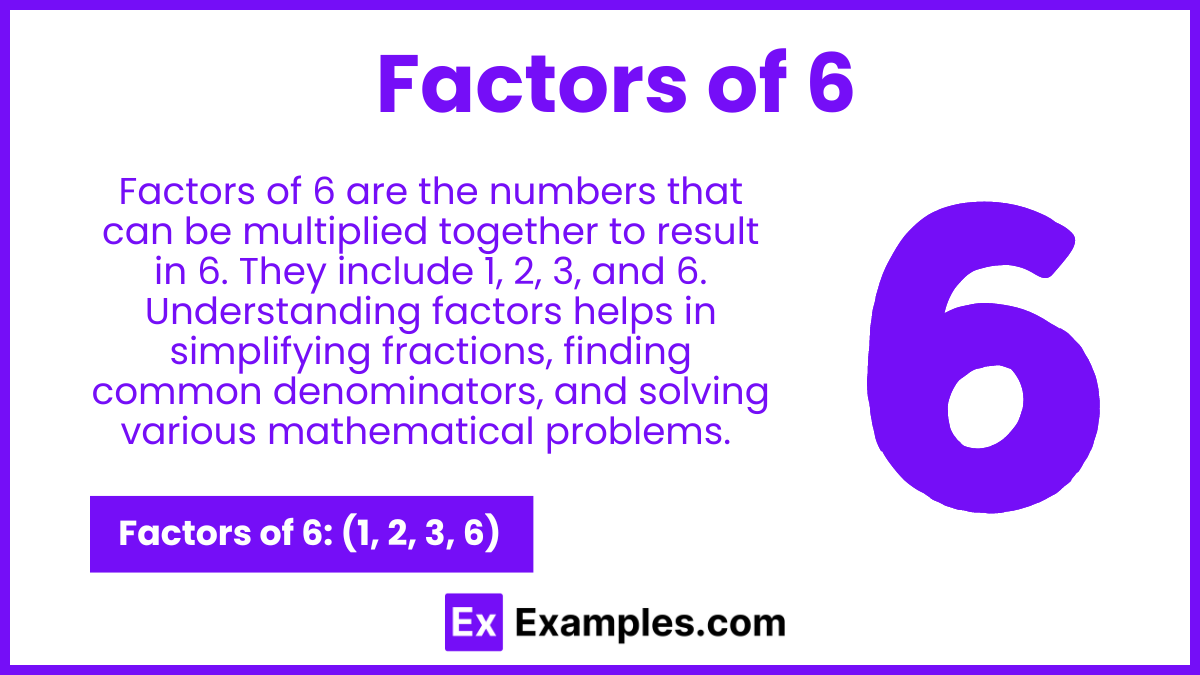What are the factors of 6?
1, 2, 3
1, 2, 3, 6
2, 4, 6
1, 2, 4, 6

The factors of 6 are the numbers that, when multiplied together, yield the product of 6. Specifically, these factors are 1, 2, 3, and 6. Understanding the factors of a number is essential in various mathematical applications, including simplifying fractions, solving equations, and finding common denominators. Factors are the building blocks of multiplication and division, providing insight into the relationships between numbers. In this article, we will explore the concept of factors, explain how to determine them, and discuss their importance in both basic arithmetic and more advanced mathematical contexts. Let’s delve into the fascinating world of factors and uncover their significance.

The factors of 6 are the numbers that can be multiplied in pairs to get the product of 6. These factors include 1, 2, 3, and 6. Specifically, 1 and 6 form one pair, while 2 and 3 form another pair. Understanding factors is essential in various mathematical contexts, such as simplifying fractions or finding common denominators. Identifying factors helps in solving problems that involve divisibility, multiplication, and the fundamental properties of numbers.
Prime factors are the prime numbers that multiply together to give a particular number. Prime numbers are numbers greater than 1 that have no divisors other than 1 and themselves.
Begin with the smallest prime number, which is 2. Check if 2 is a factor of 6.
Since 6 is an even number, it is divisible by 2. Divide 6 by 2: 6÷2=3. So, 2 is a prime factor of 6.
The quotient from the previous step is 3. Check if 3 is a prime number. Since 3 is greater than 1 and has no divisors other than 1 and itself, it is a prime number.
The prime factors of 6 are the prime numbers that we found in the previous steps. Therefore, the prime factors of 6 are: 2 and 32 and 3
Multiply the prime factors to verify the result: 2×3=6. This confirms that the prime factors of 6 are indeed correct.
Understanding the factors of a number is a fundamental concept in mathematics. Factors are numbers that divide into another number without leaving a remainder. In this guide, we’ll focus on the factors of 6 and provide tips and tricks to help you quickly and easily determine them.
Yes, both 2 and 3 are prime factors of 6 because they are prime numbers that multiply together to give 6
(2 × 3 = 6).
The sum of the factors of 6 is: 1 + 2 + 3 + 6 = 12
Factors of 6 are not directly used to find its square root, but understanding factors can help in simplifying the process of finding square roots. The square root of 6 is approximately 2.449.
The positive pair factors of 6 are (1, 6) and (2, 3). The negative pair factors of 6 are (-1, -6) and (-2, -3).
The prime factorization of 6 is 2 multiplied by 3, expressed as 6=2×3
The greatest common factor (GCF) of 6 and 3 is 3. This is the largest number that divides both 6 and 3 without leaving a remainder.
The multiples of 6 are 6, 12, 18, 24, 30, 36, 42, 48, 54, and 60. These are the numbers you get when you multiply 6 by whole numbers.
Positive pair factors of 6: (1, 6) and (2, 3)
Negative pair factors of 6: (-1, -6) and (-2, -3)
Text prompt
Add Tone
10 Examples of Public speaking
20 Examples of Gas lighting
What are the factors of 6?
1, 2, 3
1, 2, 3, 6
2, 4, 6
1, 2, 4, 6
Which of the following is not a factor of 6?
1
2
4
6
If you multiply two factors of 6, which product will not be a factor of 6?
2
3
6
12
What is the sum of all factors of 6?
7
9
12
13
Which number below is a multiple of the factors of 6?
8
10
15
18
Which factor of 6 is also a factor of 12?
4
6
1
5
Which factor pair of 6 multiplies to give 6?
(1, 4)
(2, 3)
(3, 2)
(6, 1)
How many factors does the number 6 have?
2
3
4
5
Which factor of 6 is a prime number?
2
4
6
1
Which number is not a factor of 6 but is a factor of 18?
2
3
4
6
Before you leave, take our quick quiz to enhance your learning!

